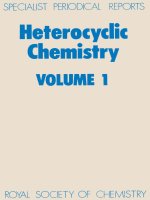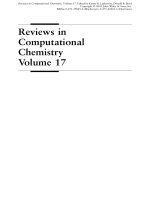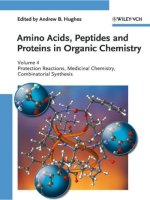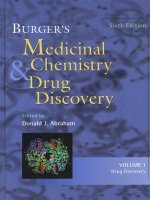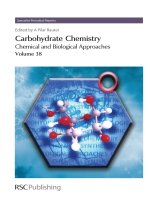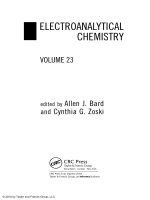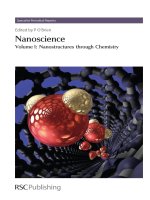Aliphatic chemistry volume 2
Bạn đang xem bản rút gọn của tài liệu. Xem và tải ngay bản đầy đủ của tài liệu tại đây (16.21 MB, 338 trang )
www.pdfgrip.com
www.pdfgrip.com
A Specialist Periodical Report
Aliphatic Chemistry
Volume 2
A Review of the Literature Published
during 1972
Sen io r Rep0 rter
W. Parker, Department of Chemistry,
University of Stirling
Reporters
R. S. Atkinson, University of Leicester
E. W. Colvin, University of Glasgow
G. Pattenden, University of Notringham
@ Copyright 1974
The Chemical Society
Burlington House, London WIV OBN.
www.pdfgrip.com
ISBN: 0851865127
Library of Congress Catalog Card No 72-83454
Printed in Northern Ireland at The Universities Press, Berfast.
www.pdfgrip.com
Foreword
The first volume of this Specialist Periodical Report was published in three
parts which provided comprehensive literature coverage of Aliphatic,
Alicyclic, and Saturated Heterocyclic Chemistry for the period January
1970-December 1971. The favourable response to this Report encouraged
us to make each of these areas in future the subject of an individual SPR
title.
This volume covers the area of Aliphatic Chemistry for the period January
-December 1972 and its overall structure is as in Part I of Volume 1.
Drs. R. S. Atkinson and E. W. Colvin have again written the chapters on
Functional Group Chemistry with an eye to providing a General Methods
report, and Dr. G . Pat tenden surveys in two chapters naturally-occurring
polyolefinic and polyacetylenic compounds and the burgeoning area of
prostaglandin chemistry.
We welcome any suggestions for improving the coverage or format of this
Report.
March I974
W. Parker
...
111
www.pdfgrip.com
www.pdfgrip.com
Contents
Chapter I Acetylenes, Alkanes, Allenes, and Alkenes
By R. S. Atkinson
3
3
3
3
12
1 Acetylenes
Reviews
Synthesis
Use of Acetylenes in Synthesis
Reactions involving Metals
Other Syntheses using Acetylenes
Cycloaddition Reactions
[2
21 Cycloadditions
Nucleophilic Additions to Acetylenes
Electrophilic Additions to Acetylenes
Radical Additions
Nucleophilic Displacement at Acetylenic Carbon
Other Acetylene Reactions of Mechanistic Interest
Theoretical Investigations
Physical Measurements
Acetylene-Allene Tnterconvcrsion
41
42
43
48
48
49
2 Alkanes
55
3 Allenes
Synthesis
Cumulenes
Allene Cycloadditions
Electrophilic Additions to Allenes
Metal-Allene Reactions
Other Reactions of Allenes
Theoretical Studies and Physical Measurements
56
+
4 Alkenes
Reviews
Synthesis
Synthesis using Simple Olefins
Olefin Reactions of Mechanistic Interest
Cycloadditions
Oxidation Reactions
Metal-Olefin Reactions
0ther Reactions
Physical Measurements
Theoretical Studies
V
12
17
19
29
35
38
56
63
64
71
72
74
76
77
77
78
91
104
104
112
115
119
125
127
www.pdfgrip.com
vi
Contents
Chapter 2
Functional Groups o t h e r than Acetylenes,
Alkanes, Allenes and Olefins
By E. W. Colvin
1 Carboxylic Acids
Synthesis
Protection
General
i28
128
128
130
131
Lactones
133
P-Hydroxy-acids and -esters
136
a-Anions
137
Esters
Synthesis
Reactions
140
140
146
6 Amides
Synthesis
0 us. N Protonation
General
152
152
154
154
Nitriles
157
Isonitriles
160
Ketones and Aldehydes
Synthesis
Masking and Regeneration
Enols and Enolates
Enones
General
162
162
168
172
177
180
10 Amines
Synthesis
Protection
General
186
186
188
189
11 AlkyI Halides
194
12 Alcohols
197
197
200
201
Synthesis
Protection
General
13 Ethers
201
14 Sulphur
203
15 Miscellaneous
209
www.pdfgrip.com
Contents
vii
Chapter 3
Naturally Occurring Polyolefinic and
Polyacety I e n ic Co mp o u nds
213
By G. Pattenden
1 Introduction
2 Naturally Occurring Polyacetylenes
Introduction
New and Known Polyacetylenes from Nature
Synthesis of Natural Polyacetylenes
Biosynthesis
3 Naturally Occurring Allenes
21 3
213
214
218
21 9
4 Natural Acetylenes and Olefins from Marine Sources
Introduction
Polyolefins from Dictyopteris
Bromo-olefins from Verongia Sponges
Enyne Cyclic Bromo-ethers from Seaweeds, Laurencia
223
223
223
225
227
5 Polyolefinic Microbial Metabolites
Polyolefinic Macrolides
Chainin
Filipin
Flavofungh
Polyfungin
Amphotericin B and Related Macrolides
Fungimycin and Candicidin
Vent uricidines
Chlorothricins
Oligomycins
Leucomycins
Erythromycins
Maridomycins
Angolamycin (Shincomycin A)
Zearalenone
Pyrenophorin
Polyolefinic Macrocycles (Non-macrolide)
The Cytochalasins
The Nonadrides and Related Compounds
Biosynthesis
Synthesis
Scytalidin
Ansamycin Antibiotics
Streptovaricins
Maytansine and Homologues
Rifamycins and Tolyponiycins
229
229
229
229
230
230
23 1
23 1
232
232
233
233
234
234
234
235
235
237
237
237
237
241
241
24 1
241
242
243
212
22 1
www.pdfgrip.com
Contents
viii
Pyran-Pyranoid Compounds
Aureotine (Aureothin)
Citreoviridin
Patulin
LL-z1220
Alicyclic Compounds
Ikarugamycin
Ascofuranone and Related Compounds
Fumagillin
6 Cyclopentenone Polyolefinic Compounds
Jasmone
Hop Constituents
7 Naturally Occurring Polyolefinic Degraded and/or
Modified Isoprenoid Compounds
Gyrinal
Pheromonal Secretion of Monarch and Queen
Butterfly
Quiesone
Blumenols, Abscissic Acid, and Theaspirone
Geijerone
Constituents of Tobacco
8 Miscellaneous Natural Polyolefins
Lactonic Compounds from Litsea japonica
Constituents of A h u s pendula
Constituents of Barlett Pears
Piperinic Acid and Its Isomers
Constituents of Cryptocavya bourdillon i
Constituents of Thalictrium aquilegifoliunt
Sex Pheromone of Laspeyresia pornoneZZa L.
Chapter 4
Chemistry of the Prostaglandins
243
243
243
244
245
245
245
246
247
248
248
25 1
252
252
253
253
254
254
255
255
255
256
256
256
256
257
257
258
By G. Pattenden
1 Introduction
258
2 Note on Nomenclature
258
3 Synthesis of Natural Prostaglandins
260
4 Synthesis of the Primary Prostaglandins
Corey’s Bicyclo[2,2,1Iheptane Route
Refinements and Modifications
New Routes to Key lnterniediates
260
260
260
262
www.pdfgrip.com
Contents
ix
New Routes from Key Intermediates
New Routes by the Merck Group
Routes involving Cyclopentane Ring Synthesis
Routes incorporating Conjugate Addition of Vinylcopper Reagents to a Functionalized Cyclopentenone
Prostaglandins from Prostaglandins
Examination of New Synthetic Approaches to
Primary Prostaglandins
266
267
27 1
273
276
276
5 Synthesis of A-Prostaglandins
278
6 Synthesis of Modified Prostaglandins
279
279
279
28 1
287
287
288
289
292
292
293
295
295
295
Deoxyprostaglandins
9-Deoxyprostaglandins
1 1-Deoxyprostaglandins
15-Deoxyprostaglandins
Bisdeoxyprostaglandins
Dihydroprostaglandins
Bishomoprostaglandins
(15S)-15-Methylprostaglandins
5-trans-Prostaglandins
1ON-Hydroxyprostaglandins
Acetylenic and Allenic Prostaglandins
Methyl 9-Oxoprost anoate
Miscellaneous Modified Prostaglandins
7 Epiprostaglandins
299
8 Prostaglandins in Coral
301
9 Metabolism of Prostaglandins
303
10 Biosynthesis of Prostaglandins
306
11 Physiological Effects of Prostaglandins
307
12 Analysis of Prostaglandins
308
13 Historical
308
Author Index
309
www.pdfgrip.com
www.pdfgrip.com
ALIPHATIC CHEMISTRY
www.pdfgrip.com
www.pdfgrip.com
Acetylenes, Alkanes, Allenes, and Al kenes
BY R. S. ATKINSON
1 Acetylenes
Reviews.-Recent reviews on areas of acetylenic chemistry include synthctic
routes to average-ring-size cycloalkynes,l a study of the bonding in metalintraacetylene complexes,2 transition-metal complexes of a~etylene,~
molecular cyclization reactions with acetylenic bond participation ,4 oligomerization of acetylenes induced by metals of the nickel triad,5 an article on
the handling of acetylenic
and a book on preparative acetylenic
chemistry
.'
Synthesis.-Numerous
examples have appeared illustrating the potential
of the method for synthesizingacetylenic carbonyl compounds by thermolysis
of hydrazones derived from a,p-epoxy-ketonesand certain 1-aminoaziridines.
As an examplc, (1) is converted via (2) into the acetylenic aldehydc (3).8
Although Michael addition of acetylenic anions to conjugated enones
failed, yS-acetylenic ketones, e.g. (4), were obtained in fair to good yield by
addition of alkynylalanes ( 5 ) . The organoalaiie is prepared from the lithium
salt of the terminal acetylene and dialkylaluminium chloride. A plausible
pathway for the reaction involves intramolecular delivery of the alkynyl group
through prior complexation with the carbonyl oxygen (6).$)
Triacetylenic boranes are derived from lithium acetylides and boron
trifluoride etherate in THF at -20 "C.They react with ethyl diazoacetate to
give homologated propargyl esters (7) after hydrolysis. Hydration of these
By-acetylenic esters using mercuric ion is regiospecific: only y-keto-esters (8)
H . Meier, Synthesis, 1972, 235.
F. R . Hartley, Angew. Chem. Internat. Edn., 1972, 11, 596.
L. D. Peltit and D. S. Barnes, Fortschr. Chem. Forsch., 1972, 28, 85.
E. E. Voyakovskaya, L. N. Shil'nikova, N. V. Koshmina, and F. Ya. Perveev, Reakrs.
spos. org. Soedinenii, 1971, 97 (Chem. Abs., 1972, 7 6 , 13 270g).
P. M. Maitlis, Pure Appl. Chern., 1972, 30, 427.
M. C. Whiting, Chem. Efig. News, 1972, 50, 86.
' L. Brandsma, 'Preparative Acetylenic Chemistry', Elsevier, New York, 1971.
D. Felix, R. K. Miiller, U. Horn, R. Joos, J. Schrcibcr, and A. Eschenmoser, Helu.
Chim.Acta, 1972, 55, 1276.
J. Hooz and R . B. Layton, J. Amer. Chem. SOC.,1971, 93, 7320.
3
www.pdfgrip.com
4
Aliphatic Chemistry
P I1
NH,
PhCECLi
+ Et2AICI -
Et2A1CrCPh + LiCl
(5)
R
are produced and no ,&keto-esters. One possibility is that carbonyl oxygen
participation is directing the hydration, as in (9):O
Transformation of aldehydes into homologated acetylenes is carried out
via the dibromo-olefin (10). Furthermore, the lithium acetylides (11) may be
treated with carbon halides, aldehydes, ketones, epoxides, or carbon dioxide
to give derivatized acetylenes.ll
/3-Keto-esters (12) are converted in good yield into 2-alkynoic esters (13)
by oxidation of their pyrazolones with thallium(m) nitrate.12 The procedure
is claimed to be simpler than the method previously used for this transformation, which involves chlorination and alkali treatment of pyraz01ones.l~
Hooz and R. B. Layton, Canad. J. Chem., 1972,30, 1105.
E. J. Corey and P. L. Fuchs, Tetrahedron Letters, 1972, 3769.
la E. C. Taylor, R. L. Robey, and A. McKillop, Angew. Chem. Internat. Edn., 1972,11,
lo J.
l1
lS
48.
A. Silveira, T. J. Weslowski, T. A. Weil, V. Kumar, and J. P. Gillespie, J . Amer.
Oil Chemists’ SOC.,1971, 48, 661.
www.pdfgrip.com
Acetylenes, Alkanes, Allenes, and Alkenes
R(C'fC),B
+ NZCHCOzEt
5
i , THF
c
RC=CCH,CO,Et
11,
H,O
(7)
OEt
RCSCCH,CO,Et
'oAcH2
\
/
-+Hg*+
1120
~
RCOCH2CH2C0,Et
/c=c\* Hg-
R
RCHo
Ph,,P-CBr,,-Zn
CH,CI,
t
RCH=CBr,
(8)
Bu1.i
or Li--€lg
RCrCLi
RC=CH
Standard oxidative coupling methods for acetylenes use the Glaser method
(CuCl, NH,Cl, aqueous alcohol, 0,) or Eglinton and Galbraith's method
[Cu(OAc),, pyridine, alcohol]. The former reaction can be accelerated by
addition of NNN'N'-tetramethylethylenediamine14 and the yield improved
by using dimethoxyethane as s01vent.l~
The triethylsilyl group has found extensive use in poly-yne synthesis. Thus
the bromoalkyne (14) is coupled to phenylacetylene (Cadiot-Chodkiewicz
Arc-CH
.+ BrC-CSiEt,
(14)
cu
----
+
+ Ar(CeC),SiEt,
EtNH,.
UMF
NaOH
-
Ar(& C),H
(15)
reaction) and the diyne (15) is liberated quantitatively on treatment with
base.le An extension of this procedure involves (a) oxidatively coupling protected terminal alkynes, (b) partially desilylating (monitoring by u.v.) and
separating, (c) recoupling, and ( d )completely desilylating [(16) 3 (17)I.l' In
addition the reagents Et,Si(C=C),H
(m = 1, 2, or 4) may be used in excess
as one component in mixed oxidative couplings, extending an acetylene by
l4
l5
l7
A. S. Hay, J. Org. Chem., 1962, 27, 3320.
V. Fritsche and S. Hunig, Tetrahedron Letters, 1972, 4831.
R. Eastmond and D. R. M. Walton, Tetrahedron, 1972, 28, 4591.
R. Eastmond, T. R. Johnson, and D. R. M. Walton, Tetrahedron, 1972, 28, 4601.
www.pdfgrip.com
6
A lipha tic Chernistry
up to four yne units in a single step after removal of the triethylsilyl group
with base.l*
Et,Si(C-C),H
((I)
-+
Et,Si(CIC),SiEt,
3
2f
Et,Si(C-C),H
(16)
-!-H(C=C),H
14
H(CEC),H
Et,Si(C--C),SiEt,
(17)
ArCu
+ ICrCSiMe,
---__
+
Arc-CSiMe,
___--
t
ArCrCH
(1 8)'
Arylacetylenes (1 8) are available by coupling of arylcopper reagent's with
iodoethynyl(trimethy1)silane (available in high yield from ICl + MqSiC=
CSiMq), the protecting group being readily detached with alkali.19 This
route is complementary to the Stephens-Castro coupling between an aryl
iodide and a suitably protected cuprous acetylide, CuC=CR.
Aromatic iodine, e.g. (19), may be exchanged for acetylenes using CuT
salts in the presence of potassium carbonate. The method avoids the requirement of dry cuprous acetylides.20
5,5-Disubstituted 3-nitroso-2-oxazolidones (20) are transformed by
butylamine in ether into acetylenes;21 2-ethynylthiophen,22 3,5-di-t-butylhave been prepared in this
phenylacetylene, and dicycl~propylacetylene~~
way.
NO
2o
21
22
23
(20)
T. R. Johnson and D. R. M. Walton, Tetrahedron, 1972, 28, 5221.
R. Oliver and D. R. M. Walton, Tetrahedron Letters, 1972, 5209.
M. S. Schvartsberg, A. A. Moroz, and I. L. Kotlyarevskii, Izuest. Akad. Nauk S.S.S.R.,
Ser. khirn., 1972, 981 (Chern. Abs., 1972, 77, 74 906m).
H. P. Hogan and J. Seehafer, J. Org. Chem., 1972, 37,4466.
T. B. Patrick, J. M. Disher, and W. J. Probst, J . Org. Chein., 1972, 37, 4467.
M . S. Newman and L. F. Lee, J. Org. CJIetn., 1972, 37,4468; M. S. Newman and S. J.
Gromelski, J. Org. Chem., 1972, 37, 3220; see also G . Kobrich, D. Merkel, and
K.-W. Thiem, Chem. Ber., 1972, 105, 1683.
www.pdfgrip.com
7
Acetylenes, Alkanes, Allenes, arid Alkenes
Stepwise addition of sulphur and cyanide to acetylides provides 1 -alkynyI
thiocyanates (21); they may be used for introduction of an R C = G S unit, as in the preparation of the previously unknown NN-dialkylalk-1ynesulphenamides (22)?p
RCrCH
UuLi
RCsCLi
d ~
9
' -
ether
RCzCSLi
k K N
RC-CSNMe,
(22)
Me,NLi
+ LiCN
RCECSCN
(21)
Ring-opening of the epoxide (23) takes place on heating with (s>-( -)-3-tbutyloxyoct-1-ynyldimethylalane(24) in toluene. This reaction is employed
in a prostaglandin synthesis which introduces the functionalized eight-carbon
side-chain in optically active form. The desired ring-opening at C-12 (prostaglandin numbering) is dependent on preliminary covalent bond formation
between the aluminium and the side-chain oxygen with subsequent intramolecular delivery of the alkyne, as in (25).25
R
c
Ill
A route to acylacetylenes uses a-diazo-P-hydroxy-ketones(or -esters) (26).
These are readily accessible by condensation of aldehydes with acyldiazornethanes2'j and yield acetylenes on treatment with boron trifl~oride.~'
24
25
26
2i
2
J. Meijer and L. Brandsma, Rec. Trau. chim., 1971, 90, 1098.
J. Fried, J, C. Sih, C. H. Lin, and P. Daven, J. Amer. Chem. SOC.,1972,94,4342,4343.
E. Wenkert and C. A. McPherson, J. Amer. Chem. SOC.,1972,94, 8804.
E. Wenkert and C. A. McPherson, Synthetic Comm., 1972, 2 , 331.
www.pdfgrip.com
Aliphatic Chemistry
8
RICH0
4-
CHCOR2
II
N2
KOH
OH
I
R'CHCCOR2
II
Nz
BF,-MeCN
t
RfC=CCOR2
Ynamines (27) are formed in the reaction of di-iminium salts (28) with
t-butoxide anion or triethylamine.2*
Directed attack on the propargyl anion occurs when the dilithium salt of
the 2-propargylthiothiazoline (29) is alkylated. The phenylpropargylated
product (30) is reduced with zinc dust and acetic acid to give the diacetylene
(31) and the allenylacetylene (32) in a ratio of 1 :8.29
Acetylenes are often found as components of synthesized macrocyclic
systems, chiefly as a result of the ease of linking two C r C units by methods
referred to earlier. Among annulenes which have been prepared by this
method are (33), (34), and (35),30 the lattercontainingthesubstituentR within
the cavity of the 7t-electron cloud. Annulenones, e.g. (36), (37), and (38),
28
29
30
L. Duhamel, P. Duhamel, and G. PIC, Tetrahedron Letters, 1972, 85.
K. Hirai and Y . Kishida, Tetrahedron Letters, 1972, 21 17.
P. J. Beeby and F. Sondheimer, J . Amer. Cliem. SOC.,
1972,94,2128; P. J. Beeby and
F. Sondheimer, Angew. Chern. Internut. Edn., 1972, 1 1 , 8 3 3 , 8 3 4 ; J. Ojima, T. Yokomachi, and T. Yokoyama, Chem. Letters, 1972, 633.
www.pdfgrip.com
Acetylenes, A Ikanes, Allenes, and Alkenes
9
Me
I
(33)
(35)
are prepared similarly,31as are [m,n]paracyclophadiynes (39) ;comparison of
the electronic spectra of these latter compounds with those of the analogous
cyclic diacetylenes (40) indicates transannular r-electronicinteraction in the
cases (rn = n = 3) and (rn = 3, n = 4).52
31
3a
P. D. Howes, E. LeGoff, and F. Sondheimer, Tetrahedron Letters, 1972, 3691, 3695;
see also the derived annulenium cation, P. D. Howes and F. Sondheimer, J. Amer.
Chem. SOC.,1972,94, 8261.
T. Matuoka, T. Negi, T. Otsubo, Y . Sakata, and S. Misumi, Bull. Chem. SOC.Japan,
1972,45, 1825.
www.pdfgrip.com
Aliphatic Chemistry
10
Various diacetyleiies have been cotistruclcd to examine enforced intramolecular interaction between triple bonds.33Synthesis of the diacetylene (41)
has been accomplished by cupric chloride coupling of 2,2’-dilithiodiphenylacetylene. The close proximity of the triple bonds in (41) results in the
formation of (42) on treatment with hydrogen bromide. No evidence was
forthcoming for an intermediate tetrahedrane (43) in reactions of (41) and its
derivatives?* A similar interaction is revealed in the reaction of (44) with
hydrogen bromide, where (45) is obtained. Alkylation of the derived dilithium diacetylide of (44)with the appropriate alkyl di-iodide gave (46).35
(44)
(45)
(46)
II =
2,3, or 4
The ring inversion barrier for (46; n = 2) was measured (n.m.r.) and found
to be 75 kJ mol-l; an X-ray structure determination of this compound has
been
together with that of 1,8-bi~(propyn-l’-yl)naphthalene.~~
Other acetylenes prepared include a-ethynylamines (47) from the corresponding alcohols;38acetylenic ethers or tertiary amines (48)by reaction of
33
34
35
38
37
38
H. A. Staab and B. Draeger, Chem. Ber., 1972, 105, 2320.
H. A. Staab, E. Wehinger, and W. Thorwart, Chem. Ber., 1972, 105, 2290.
H. A. Staab, H. Mack, and A. Nissen, Chem. Ber., 1972, 105, 2310.
H. Irngartinger, Chem. Ber., 1972, 105, 1184.
A. E. Jungk, Chem. Ber., 1972, 105, 1595.
Badische Anilin- und Soda-Fabrik, Fr. P. 2 048 865 (Chem. Abs., 1972, 76, 3392j).
www.pdfgrip.com
11
(49)
HCECMgBr
+
-
(48) Y
=
Y OH
OKor NR,
HC=CCH(CI-T,),CHkOH
NMe,
I
lithium salts (49) with aldehydes in the presence of zinc iodide;39acetylenic
amino-alcohols, e.g. (50), from acetylenic Grignard reagents and or-(dialkylamino)tetrahydropyrans;40 chlorocyanoacetylene from acrylonitrile
and chlorine;*l various acetylenes by elimination of hydrogen bromide from
1 ,Zdibromides with NaNH,-ButONa in aprotic media;42dichloroacetylene
from trichloroethylene in the presence of epoxides;43 long-chain diynoic and
triynoic acids ;4a and acetylenic derivatives of ~elenophen.4~
Convenient
procedures for the synthesis of cyclononyne and cyclonon-1-en-5-yne (51)
38
40
41
42
p3
44
46
F. Mercier, R. Epsztein, and S. Holand, Bull. SOC.chim. France, 1972, 690.
D. Couturier, Ann. Chim. (France), 1972,7, 19.
S. Morimoto, Y . Ando, Y. Miyashiro, and E. Suzuki, Takeda Chemical Industries
Ltd., Jap. P. 37 569/1971 (Chem. Abs., 1972, 76, 1 3 865e).
P. Caubere and G. Coudert, Tetrahedron, 1972, 28, 5635.
B. Dobinson and G . E. Green, Chern. and Ind., 1972, 214.
D. E. Ames and S. H. Binns, J.C.S. Perkin I, 1972, 255; W. 11. Kunau, Chem. und
Phys. Lipids, 1971, 7, 101.
A. S. Nakhamovich, V. N. Elokhina, and R. U. Karnaukhova, Khirn. geterotsikl.
Soedinenii, 1971, 7, 920 (Chem. Abs., 1972, 76, 34 052c).
www.pdfgrip.com
Aliphatic Chemistry
from the readily available bromocycloalkenols (52) and (53) have been
12
Use of Acetylenes in Synthesis.-Reactions involving Metals. The thiacycloheptyne (54)47 has been converted into an isolable cyclobutadiene-containing
dimer [(55a) or (55b)l via the yellow palladium complex (56). A distinction
between (55a) and (55b) and the extent of bond delocalization for this
I
PdCI,
J
(56)
2 (PhZPCH,),
cyclobutadiene have yet to be established; it reacts avidly with dimethyl
acetylene-dicarboxylate and oxygen!*
Cuprate species, formally R,Cu-, resulting from cuprous halide and two
equivalents of an organolithium, are useful for conjugate addition to C=CC=O and C=C--0
~ystems.4~
A disadvantage in the reaction is that
only one of the groups R is utilized. By employing the mixed cuprate
{Me(CH,),C=C)RCu, this waste can be avoided, the group R being preferentially transferred. Thus preparation of the mixed cuprate (57) and
reaction with cyclohexenone gave (58) in > 95 % yield.5O
Diacetylenes are cyclotrimerized to the unsymmetrical isomer (59) in high
yield using Ni(CO),(PPh,),. Previous catalysts for this transformation gave
low yields of symmetrical and unsymmetrical isorners.5l This catalyst also
cyclo-cotrimerizes acetylenes with olefins; N-methylmaleimide and phenylacetylene give the 2: 1 adduct (60) and the 2:2 adduct (61).5,
Hydroformylation of alkynes catalysed by rhodium normally proceeds
reluctantly and in poor yields. However, hydroformylation of but- 1- and
46
47
48
49
50
51
6a
C. B. Reese and A. Shaw, J.C.S. Chem. Comm., 1972, 787.
J. Haase and A. Krebs, Z . Naturforsch., 1972, 27a, 624; A. Krebs and H. Kimling,
Tetrahedron Letters, 1970, 761.
H. Kimling and A. Krebs, Angew. Chem. Internat. Edn., 1972,11,932.
J. F. Normant, Synthesis, 1972, 63.
E. J. Corey and D. J. Beames, J . Amer. Chem. SOC.,1972, 94, 7210.
A. J. Chalk and R. A. Jerussi, Tetrahedron Letters, 1972, 61.
A. J. Chalk, J. Amer. Chem. SOC.,1972, 94, 5928.
www.pdfgrip.com
Acetylenes, Alkanes, Allenes, and Alkenes
C3H7C-CCu
.i 2 (Me,N),P
[C3H7CGCCuR]- Li'
ii. R L i
(58)
R
=:
13
B ~ ~ , B u ~ -CH=CH,
~,or
I--\
P I1&Mc
0
+
-2-ynes to n-pentanal and 2-methylbutanal is greatly improved using a
specific excess of triphenylpho~phine.~~
Conversion of acetylenes into substituted maleate esters (62) by addition
of two carboxy-groups to the unsaturated system is achieved using palladium
and mercury salts in the presence of carbon monoxide.54Diphenylacetylene
and aromatic nitro-derivatives in the presence of carbon monoxide and
PhC=CH
+ Me0,CHgOAc + Pd(OAc),
co
Ph
H
XC0,Me
Me0,C
(62)
53
55
B. Fell and M. Beutler, Tetrahedron Letters, 1972, 3455.
R. F. Heck, J. Amer. Chem. Soc., 1972,94, 2712,
